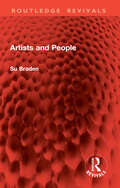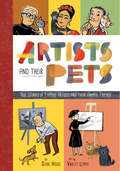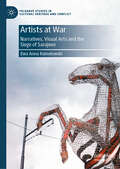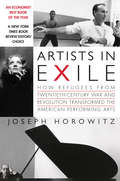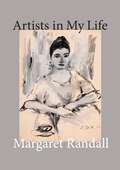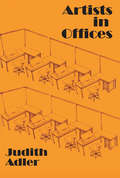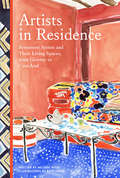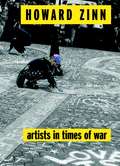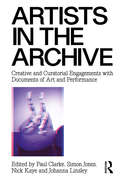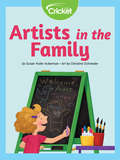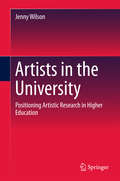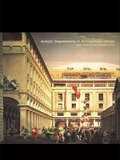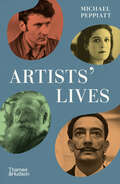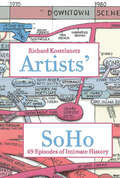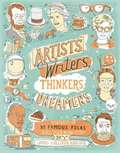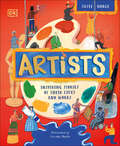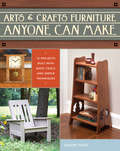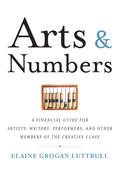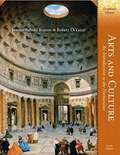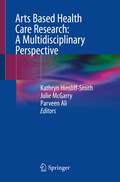- Table View
- List View
Artists and People (Routledge Revivals)
by Su BradenFirst published in 1978, Artists and People examines the formal attempts by arts administrators to set up schemes for artists to work in community contexts. The experience of creative artists who have taken up ‘residencies’ in schools, libraries and art centres is contrasted with the unique forms of expression developed by local communities themselves in new towns, housing estates, rural centres, and inner cities, in areas ranging from Tower Hamlets in London, through Craigmillar in Scotland, to new towns such as Telford and Milton Keynes.The book takes the form of a series of accounts of the experiences of artists and communities who have come together in contexts not usually seen as arenas for the arts. Su Braden looks at these experiences in the light of the philosophy that the right to artistic expression is a basic human freedom for everybody, not just for ‘artists’. In writing the book she has drawn on her experience as a community arts worker and she assesses the effect of the traditional structures (the theatre, gallery and concert hall) both on the form of art itself and the critical relationship which is intrinsic to its development. By looking at the first-hand experience of artists and local people, she has documented the dependence of much contemporary art for its form and the nature of its critical relationships on the formal structure offered by traditional outlets. In contrast, the examination of the relationship between artists and communities who have developed creative forms out of a more spontaneous recognition of mutual needs and talents reveals a new perspective on the social value of liberating artistic expression from its formal restraints.
Artists and Signatures in Ancient Greece
by Jeffrey M. HurwitThe Greeks inscribed their works of art and craft with labels identifying mythological or historical figures, bits of poetry, and claims of ownership. But no type of inscription is more hotly debated or more intriguing than the artist's signature, which raises questions concerning the role and status of the artist and the work of art or craft itself. In this book, Jeffrey M. Hurwit surveys the phenomenon of artists' signatures across the many genres of Greek art from the eighth to the first century BCE. Although the great majority of extant works lack signatures, the Greek artist nonetheless signed his products far more than any other artist of antiquity. Examining signatures on gems, coins, mosaics, wall-paintings, metalwork, vases, and sculptures, Hurwit argues that signatures help us assess the position of the Greek artist within his society as well as his conception of his own skill and originality.
Artists and Their Pets: True Stories of Famous Artists and Their Animal Friends
by Susie Hodge Violet LemayDid you know that the great Pablo Picasso had many pets, including a white mouse and a goat? And that Andy Warhol loved his dachshunds, Salvador Dalí liked ocelots and anteaters, and Georgia O’Keeffe had a passion for chows and Siamese cats? Artists and Their Pets tells these stories and many more with full-color illustrations and a chirpy narrative that will delight both art buffs and pet enthusiasts. Lexile: 1140L
Artists and the Arab Uprisings
by Lowell H. Schwartz Dalia Dassa Kaye Jeffrey MartiniRegional artists can play a positive role in shaping public debate and supporting democratic transition in the Middle East. This report explores the challenges artists have faced since the Arab uprisings, U. S. government programs to support arts in the region, and the wide array of nongovernmental activities to engage Arab artists, offering recommendations to improve support for these artists.
Artists at War: Narratives, Visual Arts and the Siege of Sarajevo (Palgrave Studies in Cultural Heritage and Conflict)
by Ewa Anna KumelowskiThis book follows the lives of Sarajevan visual artists as they responded to the rising instability and political fragmentation that defined the last days of Yugoslavia&’s existence. Exploring how these artists understood and spoke about the onset of war, it places a focus on a series of recognizable discourses, touching upon notions of Yugoslav common culture, civilization and cultural resistance, which have since become synonymous with the memory of the siege of Sarajevo. This book hinges its central arguments on a microhistorical reading of this unique cultural community that existed simultaneously on the practical periphery of Yugoslav cultural developments and within the center of the state&’s fragmentation. In doing so, it offers a novel approach towards understanding the experiences of everyday life in besieged Sarajevo
Artists in Exile
by Joseph HorowitzDuring the first half of the twentieth century--decades of war and revolution in Europe--an "intellectual migration" relocated thousands of artists and thinkers to the United States, including some of Europe's supreme performing artists, filmmakers, playwrights, and choreographers. For them, America proved to be both a strange and opportune destination. A "foreign homeland" (Thomas Mann), it would frustrate and confuse, yet afford a clarity of understanding unencumbered by native habit and bias. However inadvertently, the condition of cultural exile would promote acute inquiries into the American experience. What impact did these famous newcomers have on American culture, and how did America affect them? George Balanchine, in collaboration with Stravinsky, famously created an Americanized version of Russian classical ballet. Kurt Weill, schooled in Berlin jazz, composed a Broadway opera. Rouben Mamoulian's revolutionary Broadway productions of Porgy and Bess and Oklahoma! drew upon Russian "total theater." An army of German filmmakers--among them F. W. Murnau, Fritz Lang, Ernst Lubitsch, and Billy Wilder--made Hollywood more edgy and cosmopolitan. Greta Garbo and Marlene Dietrich redefined film sexuality. Erich Korngold upholstered the sound of the movies. Rudolf Serkin inspirationally inculcated dour Germanic canons of musical interpretation. An obscure British organist reinvented himself as "Leopold Stokowski." However, most of these gifted émigrés to the New World found that the freedoms they enjoyed in America diluted rather than amplified their high creative ambitions.A central theme of Joseph Horowitz's study is that Russians uprooted from St. Petersburg became "Americans"--they adapted. Representatives of Germanic culture, by comparison, preached a German cultural bible--they colonized. "The polar extremes," he writes, "were Balanchine, who shed Petipa to invent a New World template for ballet, and the conductor George Szell, who treated his American players as New World Calibans to be taught Mozart and Beethoven." A symbiotic relationship to African American culture is another ongoing motif emerging from Horowitz's survey: the immigrants "bonded with blacks from a shared experience of marginality"; they proved immune to "the growing pains of a young high culture separating from parents and former slaves alike."
Artists in My Life
by Margaret RandallMargaret Randall reveals personal stories and profound insights about the artists who most influenced her life.Artists in My Life is a collection of intimate and conversational accounts of the visual artists that have impacted the renowned poet activist Margaret Randall on her own journey as an artist. Randall writes of each relationship through multiple lenses: as makers of art, social commentators, women in a world dominated by male values, and in solitude or collaboration with communities and the larger artistic arena. Each story offers insight into the artist’s life and work, and analyses the impact it had on Randall’s own work and its impact on the larger art community. The work strives to answer bigger questions about visual art as a whole and its lasting political influence on the world stage. Randalls describes her motivations: ”I go beneath the surface, asking questions and telling stories. I have wanted to answer questions such as: Why is it that visual art—drawing, painting, sculpture, photography, architecture—grabs me and, in particular instances, feels as if it changes me at the molecular level? How do art and memory interact? How do reason and intuition come together in art? Do women and men make art differently? Does great art change the viewer? Does it change the artist? How does art travel through time?”
Artists in Offices: An Ethnography of an Academic Art Scene
by Judith E. AdlerUniversities have become important sources of patronage and professional artistic preparation. With the growing academization of art instruction, young artists are increasingly socialized in bureaucratic settings, and mature artists find themselves working as organizational employees in an academic setting. As these artists lose the social marginality and independence associated with an earlier, more individual aesthetic production, much cultural mythology about work in the arts becomes obsolete.This classic ethnography, based on fieldwork and interviews carried out at the California Institute of the Arts in the 1980s, analyzes the day-to-day life of an organization devoted to work in the arts. It charts the rise and demise of a particular academic art "scene," an occupational utopian community that recruited its members by promising them an ideal work setting.Now available in paperback, it offers insight into the worlds of art and education, and how they interact in particular settings. The nature of career experience in the arts, in particular its temporal structure, makes these occupations particularly receptive to utopian thought. The occupational utopia that served as a recruitment myth for the particular organization under scrutiny is examined for what it reveals about the otherwise unexpressed impulses of the work world.
Artists in Residence: Seventeen Artists and Their Living Spaces, from Giverny to Casa Azul
by Melissa WyseArtists in Residence explores the homes of 17 legendary and contemporary artists.Readers can peek inside Georgia O'Keeffe's adobe courtyards, stroll through Henri Matisse's vibrant aviary, and peruse Jean-Michel Basquiat's collection of over 1,000 videotapes.A house or an apartment is not simply a place to eat and sleep for these artists; they transform quotidian spaces into dynamic reflections of their individual artistic preoccupations.• Offers a fascinating and inspiring blend of art history, interior design, and travel• Invites readers to peer behind the closed doors of top artists from around the world• Richly illustrated throughoutThrough vivid text and image, Artists in Residence explores how each artist's living space relates to their individual and distinct artist practice.Readers gain a deeper appreciation of their favorite artists' work, and perhaps discover a new favorite visual along the way.• This petite jacketed hardcover book makes a wonderful gift for artists and art fans everywhere.
Artists in Times of War (Open Media Series)
by Howard Zinn"Political power," says Howard Zinn, "is controlled by the corporate elite, and the arts are the locale for a kind of guerrilla warfare in the sense that guerrillas look for apertures and opportunities where they can have an effect." In Artists in Times of War, Zinn looks at the possibilities to create such apertures through art, film, activism, publishing and through our everyday lives. In this collection of four essays, the author of A People's History of the United States writes about why "To criticize the government is the highest act of patriotism." Filled with quotes and examples from the likes of Bob Dylan, Mark Twain, e. e. cummings, Thomas Paine, Joseph Heller, and Emma Goldman, Zinn's essays discuss America's rich cultural counternarratives to war, so needed in these days of unchallenged U.S. militarism.
Artists in the Archive: Creative and Curatorial Engagements with Documents of Art and Performance
by Simon Jones Paul Clarke Nick Kaye Johanna LinsleyArtists in the Archive explores the agency and materiality of the archival document through a stunning collection of critical writings and original artworks. It examines the politics and philosophy behind re-using remains, historicising this artistic practice and considering the breadth of ways in which archival materials inform, inflect and influence new works. Taking a fresh look at the relationships between insider know-how and outsider knowledge, Artists in the Archive opens a vital dialogue between a global range of artists and scholars. It seeks to trouble the distinction between artistic practice and scholarly research, offering disciplinary perspectives from experimental theatre, performance art, choreography and dance, to visual art making, archiving and curating.
Artists in the Family
by Susan Yoder AckermanAunt Tonya is coming to visit! Viv wants to surprise her with a drawing, but she doesn’t think she is very good at art. Together with her brother, Emmett, they plot to create a map of memories and take Aunt Tonya on an adventure! Along the way, Viv discovers that perhaps she is an artist, after all!
Artists in the University: Positioning Artistic Research in Higher Education
by Jenny WilsonThis book focuses on the relationship between the university and a particular cohort of academic staff: those in visual and performing arts disciplines who joined the university sector in the 1990s. It explores how artistic researchers have been accommodated in the Australian university management framework and the impact that this has had on their careers, identities, approaches to their practice and the final works that they produce. The book provides the first analysis of this topic across the artistic disciplinary domain in Australia and updates the findings of Australia's only comprehensive study of the position of research in the creative arts within the government funding policy setting reported in 1998 (The Strand Report). Using lived examples and a forensic approach to the research policy challenges, it shows that while limited progress has been made in the acceptance of artistic research as legitimate research, significant structural, cultural and practical cha llenges continue to undermine relationships between universities and their artistic staff and affect the nature and quality of artistic work.
Artists' Impressions in Architectural Design: Null
by Bob Giddings Margaret HorneArtists' Impressions in Architectural Design analyses the ways in which architects have presented their designs for clients and the public, both historically and contemporarily. It spans a period from the fifteenth to the twenty-first century.Architects have become familiar with change. The passage of time has brought with it new and revived styles of architecture, as well as innovative tools and techniques for their representation. The result is that while some methods show a view of the architect's concept for a building, others offer an almost real experience of the intended architecture. This book provides a rare and valuable study in which the exciting technological developments of today are placed in context with the rich heritage of the past. It offers an opportunity to learn how architects have chosen to represent their ideas. The authors dare to glimpse into the future and hopefully offer some reassurance for tomorrow.
Artists' Lives
by Michael PeppiattEngaging encounters, personal anecdotes, and jargon-free critical insights into some of the liveliest creative minds in modern art, by an international art-world insider. Praised by The Art Newspaper as “the best art writer of his generation,” Michael Peppiatt has encountered many European modern artists over more than fifty years. This selection of some of his best biographical writing covers a wide spectrum of modern art, from Van Gogh and Pierre Bonnard, to conversations with painter Sonia Delaunay, artist and photographer Dora Maar, who was Picasso’s lover in the 1930s and 1940s, and Francis Bacon, perhaps the most famous of the many artists with whom Peppiatt has formed personal friendships. Michael Peppiatt’s lively, engaging writing introduces us to many notable art-world personalities, such as the Catalan painter Antoni Tàpies, whom he visits in his studio, and moments of disillusion, such as his meeting with the self-mythologizing artist Balthus. Art criticism blends with anecdote: Peppiatt recalls riding with Lucian Freud in his Bentley, drinking with Bacon in Soho, and many more revealing moments. This collection of Peppiatt’s most perceptive texts includes encounters with underrecognized artists, such as Dachau survivor Zoran Mušic, or Montenegrin artist Dado, whose retrospective Peppiatt curated at the 2009 Venice Biennale. Remarkably varied in their scope and lucidly written for a general reader, these selected essays not only provide us with perceptive commentary and acute critical judgment, they also give a unique personal insight into some of the greatest creative minds of the modern era. This book is a must-read for all lovers of modernism and post-war paintingin particular.
Artists' SoHo: 49 Episodes of Intimate History
by Richard KostelanetzDuring the 1960s and 1970s in New York City, young artists exploited an industrial wasteland to create spacious studios where they lived and worked, redefining the Manhattan area just south of Houston Street. Its use fueled not by city planning schemes but by word-of-mouth recommendations, the area soon grew to become a world-class center for artistic creation—indeed, the largest urban artists’ colony ever in America, let alone the world.Richard Kostelanetz’s Artists’ SoHo not only examines why the artists came and how they accomplished what they did but also delves into the lives and works of some of the most creative personalities who lived there during that period, including Nam June Paik, Robert Wilson, Meredith Monk, Richard Foreman, Hannah Wilke, George Macuinas, and Alan Suicide. Gallerists followed the artists in fashioning themselves, their homes, their buildings, and even their streets into transiently prominent exhibition and performance spaces.SoHo pioneer Richard Kostelanetz’s extensively researched intimate history is framed within a personal memoir that unearths myriad perspectives: social and cultural history, the changing rules for residency and ownership, the ethos of the community, the physical layouts of the lofts, the types of art produced, venues that opened and closed, the daily rhythm, and the gradual invasion of “new people.” Artists’ SoHo also explores how and why this fertile bohemia couldn’t last forever. As wealthier people paid higher prices, galleries left, younger artists settled elsewhere, and the neighborhood became a “SoHo Mall” of trendy stores and restaurants.Compelling and often humorous, Artists’ SoHo provides an analysis of a remarkable neighborhood that transformed the art and culture of New York City over the past five decades.
Artists, Writers, Thinkers, Dreamers
by James Gulliver HancockThis cultural who's-who illuminates 50 famous figures, from Leonardo da Vinci to Coco Chanel, through the fascinating trivia of their lives. Artist James Gulliver Hancock depicts historical icons in quirky annotated portraits surrounded by their associated possessions, baggage, and foibles. Hemingway's hobbies, Amelia Earhart's preferred dessert, Martin Luther King Jr.'s favorite TV show--each portrait reveals the ordinary quirks of these extraordinary people and captures their personalities in the process. An exquisitely illustrated almanac and cultural literacy cheat sheet, this fun and informative collection offers both history buffs and art lovers a treasure trove of interesting facts about beloved artists, writers, thinkers, and dreamers.
Artists, Writers, Thinkers, Dreamers: Portraits of Fifty Famous Folks & All Their Weird Stuff
by James Gulliver HancockThis cultural who's-who illuminates 50 famous figures, from Leonardo da Vinci to Coco Chanel, through the fascinating trivia of their lives. Artist James Gulliver Hancock depicts historical icons in quirky annotated portraits surrounded by their associated possessions, baggage, and foibles. Hemingway's hobbies, Amelia Earhart's preferred dessert, Martin Luther King Jr.'s favorite TV show—each portrait reveals the ordinary quirks of these extraordinary people and captures their personalities in the process. An exquisitely illustrated almanac and cultural literacy cheat sheet, this fun and informative collection offers both history buffs and art lovers a treasure trove of interesting facts about beloved artists, writers, thinkers, and dreamers.
Artists: Inspiring Stories of Their Lives and Works (DK Explorers)
by DKExtraordinary reference book of over 80 famous painters, their lives, their loves and their iconic paintings.This art book includes insightful biographies of artists accompanied with remarkable reproductions of their famous artworks. Begin with the early Renaissance and follow art movements through the centuries to some of the most well-known artists alive today.A gorgeous exploration of the defining people of the art world including pioneers like Giotto and Jan van Eyck, the greats like Leonardo da Vinci and Raphael, and the visionaries like Frida Kahlo and Hokusai. The large format art book is overflowing with information and pictures of your favorite classics. The full-page prints are especially spectacular, allowing you to get the full effect of the work that inspired, defined and encapsulated art movements.Over 500 years of the craft is discussed, with the chapters organized by century starting with "Before 1500&” and ending with &“1945 – Present.&” Each chapter features the relevant painters of those years with its own directory. Read about the historical context of art movements in sections which include timelines and fact panels giving incredible insight into the art world, the past lives of artists and their visions and techniques. Discover the unconventional stories of the artists' lives, including their influences, developments, friendships, loves and rivalries. Read about the portraits that Holbein did for Henry VIII to play matchmaker, Caravaggio's astonishing reaction to a badly cooked artichoke and the many romantic affairs of Picasso. Sometimes scandalous and often tumultuous, the lives of artists like Raphael, Hogarth, van Gogh, O'Keeffe, Magritte, Warhol and Kiefer are as interesting and captivating as their work. The Artists Behind the Paint BrushesA beautiful coffee table book that would make a lovely gift for those interested in art history and artist biographies, or to browse the attractive reproductions of the famous artworks. Includes a foreword by Ross King, who is the author of the bestselling Brunelleschi's Dome and Michelangelo and the Pope's Ceiling, as well as the novels Ex-Libris and Domino. • Over 80 biographies of the standout artists over the centuries since the early Renaissance. • Beautiful reproductions of artworks that allow you to get up close to their brush strokes. • Insight into historical art themes and movements that influenced the periods.
Artists’ Voices in Cultural Policy: Careers, Myths And The Creative Profession After German Unification (New Directions In Cultural Policy Research )
by Simone WesnerOffers a combined focus on professionalization, career development, and cultural policy within the field of cultural policy research<p><p> This volume examines visual artists’ careers in the East German region of Saxony, as seen through the lens of cultural policy studies. The book discusses how myth binaries, memory layers and identity markers shaped artists professional lives in an interwoven and fluid approach following German unification, taking a fresh look at the intricacies of visual artists’ careers within the specifics of the cultural, social and political changes. It surveys artists’ professional practice and work under the new framework of the professional class, and discusses the implications for the profession of artists with special reference to visual artists. Simone Wesner looks beyond geographical and political contexts and provides the reader with a longitudinal narrative that produces a revised understanding of artists’ careers within the cultural policy context.
Arts & Crafts Furniture Anyone Can Make
by David ThielGood Looking and Simple Furniture doesn't have to be complicated to be good looking. By reducing classic Arts & Crafts furniture designs to their basics, then adding simple, screw-together joinery, anyone can build great-looking furniture. Using basic tools (jigsaw, miter saw or circular saw and a cordless drill) even as a first-time woodworker you can successfully create a piece of furniture in a weekend that you'll proudly display for years. Each of the traditional (and some original) have designs in Arts & Crafts Furniture Anyone Can Make have been adjusted for size to accommodate the standard poplar, red oak or pine boards readily available at your local home center. The boards are sold cut to thickness and width, so with most of the projects all you need to do is cut the pieces to length and put them together. Even the finishes used are "off-she-shelf," relying on stains, paints and finish coats that are sold in any home center, and are easy to apply. Pick up some supplies today and build one of these classic projects!
Arts & Ideas (7th edition)
by William FlemingIntended for courses in Western Humanities, this book chronologically explores the major styles as they appear in painting, sculpture, architecture, literature, music, and philosophy from antiquity to present using lively anecdotes.
Arts & Numbers
by Elaine Grogan LuttrullThe creative class-artists, actors, writers, musicians, freelancers, dancers, performers, and the like-are known for applying their passion for creative expression to everything they do. Perhaps the one thing that most fills this group with apprehension is the rigid world of numbers. This leads to problems arising from the unconventional financial and business situations of creative professionals, as well as the nonprofit organizations with which they're often affiliated. Finances, budgeting, and business matters can be dreaded, if not outright ignored, by creatives--to the detriment of their artistic pursuits.Author, artist, and CPA Elaine Grogan Luttrull has written Arts & Numbers to help creative professionals find the same confidence in their financial dealings as in their chosen mode of expression. It is an engaging, accessible guide that covers a variety of must-know topics, such as budgeting, cash management, visual charting, taxes, employment, and business etiquette. In a simple, straightforward style, Luttrull draws examples from smooth-flowing narratives depicting common issues within the arts worlds, as well as from her own personal anecdotes. Unlike stuffy textbooks and patronizing business books, Arts & Numbers is a lively and artfully done ally in helping creative professionals plan their present financial situations and secure their futures.
Arts And Culture: An Introduction To The Humanities, Combined Volume
by Janetta Rebold Benton Robert DiYanniOffering an exploration of Western and World civilization's cultural heritage, this book is richly illustrated, beautifully designed and engaging.Readers move chronologically through major periods and stylesfrom prehistoric culture to 20th Century Americato gain insight into the achievements and ideas in painting, sculpture, architecture, literature, philosophy, religion, and music.For arts and cultural coordinators, professionals and enthusiasts.
Arts Based Health Care Research: A Multidisciplinary Perspective
by Parveen Ali Julie McGarry Kathryn Hinsliff-SmithThis book, written by academics across a range of disciplines, including healthcare and social sciences discusses the increasing use of the arts in healthcare research, which often stems from the recognition that for some topics of investigation, or when dealing with sensitive issues, the usual qualitative or quantitative paradigms are not appropriate. While there is undoubtedly a place for such approaches, arts-based research paradigms (ABR) offers, not only additional study and data-collection tools, but also provides a new and enjoyable experience for those involved. The use of the arts as a medium to improve health and wellbeing was well documented by the World Health Organisation (WHO) in 2019, with over 3,000 studies conducted around the globe on the value of the arts in the prevention of ill health and promotion of health across the life span. This book examines how the arts, in a variety of forms, can be used by those working directly in healthcare settings as well as those involved in research across all health or patient settings. Covering a range of ABR genres, including literature (such as narrative and poetic inquiry); performance (music, dance, play building); visual arts (drawing and painting, collage, installation art, comics); and audio-visual and multimethod approaches, this user- friendly book will appeal to nurses, researchers in nursing and allied healthcare professions, as well professionals in the social sciences, psychosociology, psychology, literature and arts.
